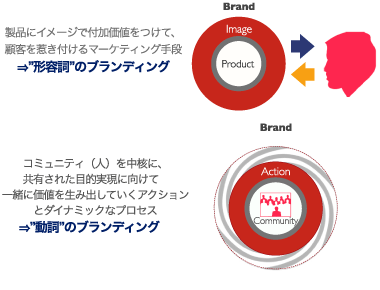Last time, we discussed reframing branding as an activity for building real communities. So how does this methodology differ from previous approaches? In a word, the key shift is "from adjectives to verbs."
In today's era of information overload, it's increasingly difficult for companies to effectively impress their brand messages and images upon people and capture their interest. Busy consumers, overwhelmed by processing endless information, increasingly tend to block out irrelevant content. Brand messages won't resonate unless they evoke personal connection or inspire a desire to share them with others. What modern marketers care about most is likely whether there's "any reaction" or if their brand is "trending."
On the other hand, information about brands they engage with, or themes and events they care about, now spreads widely through social media. Furthermore, the significant reduction in the cost for companies to maintain direct, ongoing relationships with customers has made it easier for brands to support activities where interested users and fans participate, share content themselves, and work together to achieve goals.
For people today, owning and consuming things isn't just about survival; it carries meaning in terms of connections with people and society, sharing values, and expressing individuality. When brands foster human connections and support community building, it opens the possibility of creating a more fundamental brand value—a value for people—that transcends the product itself. If this goes beyond mere information provision or image building to become a centripetal force driving participants' actions and changing reality, it can generate greater brand support and resonance.
 Now, let's define the traditional marketing approach—adding value to products through advertising, design, and other image-building tactics to attract customers—as "adjective" branding. Here, "adjective" refers to the unilateral control of brand image by companies over consumers, creating perceptions like "cool," "approachable," or "trustworthy."
Now, let's define the traditional marketing approach—adding value to products through advertising, design, and other image-building tactics to attract customers—as "adjective" branding. Here, "adjective" refers to the unilateral control of brand image by companies over consumers, creating perceptions like "cool," "approachable," or "trustworthy."
In contrast, as mentioned earlier, today's brand-building increasingly centers on communities of people rather than products. Users and consumers are also value creators. By establishing communities as spaces, we foster actions and dynamic processes where value is co-created. We call this "verb" branding. (Right figure)
Our "Brand Community Strategy for the Social Era" covers concrete examples from various leading brands and their practical approaches. For details, please refer to that resource. By viewing brands as "community platforms," it becomes possible to expand new value and business opportunities based on relationships with users, transcending short-term campaign activities. Next time, I'd like to explain these points further.
*Diamond Online features a dialogue article introducing various case studies related to this topic. We encourage you to take a look.

 Now, let's define the traditional marketing approach—adding value to products through advertising, design, and other image-building tactics to attract customers—as "adjective" branding. Here, "adjective" refers to the unilateral control of brand image by companies over consumers, creating perceptions like "cool," "approachable," or "trustworthy."
Now, let's define the traditional marketing approach—adding value to products through advertising, design, and other image-building tactics to attract customers—as "adjective" branding. Here, "adjective" refers to the unilateral control of brand image by companies over consumers, creating perceptions like "cool," "approachable," or "trustworthy."
